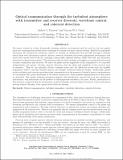Optical communication through the turbulent atmosphere with transmitter and receiver diversity, wavefront control, and coherent detection
Author(s)
Puryear, Andrew L.; Chan, Vincent W. S.
DownloadPuryear-2009-Optical communication through the turbulent atmosphere with transmitter and receiver diversity, wavefront control, and coherent detection.pdf (710.4Kb)
PUBLISHER_POLICY
Publisher Policy
Article is made available in accordance with the publisher's policy and may be subject to US copyright law. Please refer to the publisher's site for terms of use.
Terms of use
Metadata
Show full item recordAbstract
Net-centric warfare in todays dynamically changing military environments and the need for low-cost gigabit intra-city communication present severe challenges for current free-space optical systems. Enabled by high-speed electronics and advances in wavefront control, we develop an architecture that provides free-space coherent optical links with information capacity, security, network robustness and power management performance that exceed the current state-of-the-art, including commercially deployed systems, R&D test-beds, and alternative theoretical architectures proposed. The deleterious effects of the turbulent atmosphere are mitigated with several diversity transmitters and receivers. We allow the phase and the amplitude of each transmitter to be controlled independently and assume, through coherent detection, that the phase and amplitude of the received wave is measured. Thus we can optimally allocate transmit power into the diffraction modes with the smallest propagation losses to increase channel capacity and mitigate turbulence-induced outages. Additionally, spatial mode modulation and rejection provides robust communication in the presence of denial of service via interference by adversaries with a priori knowledge of the system architecture. Some possible implementations of this system are described. New results, including asymptotic singular value distribution, expected bit error rate, interference performance, and performance in the presence of inhomogeneous turbulence, are given. Finally, performance of this system is compared with the performance of optical diversity systems without wavefront control and optical systems without diversity, both current state-of-the-art systems.
Date issued
2009-08Department
Lincoln Laboratory; Massachusetts Institute of Technology. Department of Electrical Engineering and Computer ScienceJournal
Proceedings of SPIE
Publisher
The International Society for Optical Engineering
Citation
Puryear, Andrew L., and Vincent W. S. Chan. “Optical communication through the turbulent atmosphere with transmitter and receiver diversity, wavefront control, and coherent detection.” Free-Space Laser Communications IX. Ed. Arun K. Majumdar & Christopher C. Davis. San Diego, CA, USA: SPIE, 2009. 74640J-17. © 2009 SPIE--The International Society for Optical Engineering
Version: Final published version
ISSN
0277-786X